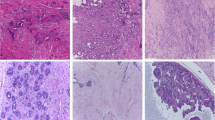Abstract
Stain separation is an important pre-processing technique used to aid automated analysis of histopathology images. In this paper, we propose a novel, unsupervised deep learning method for stain separation (Hematoxylin and Eosin). This approach is inspired by Non-Negative Matrix Factorisation (NMF) and decomposes an input image into a stain colour matrix and a stain concentration matrix. In contrast to existing approaches, our method predicts stain colour matrices at the pixel level rather than the image level, thus enabling implicit modelling of tissue-dependant interactions between stains. We demonstrate an 8.81% reduction in mean-squared error on a stain separation task measuring the similarity between predicted and actual hematoxylin images from a publicly available dataset of digitised tissue images. We also present a novel approach to artifact detection in histological images based on a constrained generative adversarial network which we demonstrate is able to detect a variety of artifact types without the use of labels.
Access this chapter
Tax calculation will be finalised at checkout
Purchases are for personal use only
Similar content being viewed by others
References
Sethi, A., et al.: Empirical comparison of color normalization methods for epithelial-stromal classification in H and E images. J. Pathol. Inform. 7(1), 17 (2016). https://doi.org/10.4103/2153-3539.179984. ISSN 2153-3539. http://www.jpathinformatics.org/text.asp?2016/7/1/17/179984. Accessed 07 Mar 2019
Haub, P., Meckel, T.: A model based survey of colour deconvolution in diagnostic brightfield microscopy: error estimation and spectral consideration. Sci. Rep. 5(1), 12096 (2015). https://doi.org/10.1038/srep12096. ISSN 2045-2322. http://www.nature.com/articles/srep12096. Accessed 07 Mar 2019
Vahadane, A., et al.: Structure-preserving color normalization and sparse stain separation for histological images. IEEE Trans. Med. Imaging 35(8), 1962–1971 (2016). https://doi.org/10.1109/TMI.2016.2529665. ISSN 0278-0062, 1558-254X. http://ieeexplore.ieee.org/document/7460968/. Accessed 07 Mar 2019
Ruifrok, A.C., Johnston, D.A.: Quantification of histochemical staining by color deconvolution, p. 9 (2001). https://pubmed.ncbi.nlm.nih.gov/11531144/#:~:text=Quantification%20of%20Histochemical%20Staining%20by%20Color%20Deconvolution%20-,samples%20stained%20with%20up%20to%20three%20different%20
LeFevre, M.E., et al.: Frequency of black pigment in livers and spleens of coal workers: correlation with pulmonary pathology and occupational information. Hum. Pathol. 13(12), 1121–1126 (1982). https://doi.org/10.1016/S0046-8177(82)80250-5. ISSN 0046-8177. http://www.sciencedirect.com/science/article/pii/S0046817782802505
Alsubaie, N., Raza, S.E.A., Rajpoot, N.: Stain deconvolution of histology images via independent component analysis in the wavelet do main. In: 2016 IEEE 13th International Symposium on Biomedical Imaging (ISBI), pp. 803–806, April 2016. https://doi.org/10.1109/ISBI.2016.7493388
Macenko, M., et al.: A method for normalizing histology slides for quantitative analysis. In: 2009 IEEE International Symposium on Biomedical Imaging: From Nano to Macro, pp. 1107–1110, June 2009. https://doi.org/10.1109/ISBI.2009.5193250
Gavrilovic, M., et al.: Blind color decomposition of histological images. IEEE Trans. Med. Imaging 32(6), 983–994 (2013). https://doi.org/10.1109/TMI.2013.2239655. ISSN 0278-0062
Kather, J.N., et al.: New colors for histology: optimized bivariate color maps increase perceptual contrast in histological images. PLoS ONE 10(12), e0145572 (2015). https://doi.org/10.1371/journal.pone.0145572. Ed. by Jonathan A Coles. ISSN 1932-6203. https://dx.plos.org/10.1371/journal.pone.0145572. Accessed 07 Mar 2019
Trahearn, N., et al.: Multi-class stain separation using independent component analysis. In: Gurcan, M.N., Madabhushi, A. (eds.) Orlando, Florida, United States, p. 94200J, March 2015. https://doi.org/10.1117/12.2081933. http://proceedings.spiedigitallibrary.org/proceeding.aspx?doi=10.1117/12.2081933. Accessed 07 Mar 2019
Alsubaie, N., et al.: Stain deconvolution using statistical analysis of multi-resolution stain colour representation. PLoS ONE 12(1), e0169875 (2017). https://doi.org/10.1371/journal.pone.0169875. Ed. by Cesario Bianchi. ISSN 1932-6203. https://dx.plos.org/10.1371/journal.pone.0169875. Accessed 07 Mar 2019
Rabinovich, A., et al.: Unsupervised color decomposition of histologically stained tissue samples. In: Advances in Neural Information Processing Systems (2004). ISSN 10495258
McCann, M.T., et al.: Algorithm and benchmark dataset for stain separation in histology images. In: 2014 IEEE International Conference on Image Processing (ICIP), pp. 3953–3957. IEEE (2014)
Ronneberger, O., Fischer, P., Brox, T.: U-Net: convolutional networks for biomedical image segmentation. In: Navab, N., Hornegger, J., Wells, W.M., Frangi, A.F. (eds.) MICCAI 2015. LNCS, vol. 9351, pp. 234–241. Springer, Cham (2015). https://doi.org/10.1007/978-3-319-24574-4_28
Goodfellow, I., et al.: Generative adversarial nets. In: Advances in Neural Information Processing Systems, pp. 2672–2680 (2014)
Acknowledgements
This work was financially supported by Invest NI, the Natural Science Foundation of Jiangsu Province, China under Grant No. BK20170443 and the Natural Science Foundation of the Higher Education Institutions of Jiangsu Province, China under Grant No. 17KJB520030.
Author information
Authors and Affiliations
Corresponding author
Editor information
Editors and Affiliations
Rights and permissions
Copyright information
© 2020 Springer Nature Switzerland AG
About this paper
Cite this paper
Moyes, A., Zhang, K., Ji, M., Zhou, H., Crookes, D. (2020). Unsupervised Deep Learning for Stain Separation and Artifact Detection in Histopathology Images. In: Papież, B., Namburete, A., Yaqub, M., Noble, J. (eds) Medical Image Understanding and Analysis. MIUA 2020. Communications in Computer and Information Science, vol 1248. Springer, Cham. https://doi.org/10.1007/978-3-030-52791-4_18
Download citation
DOI: https://doi.org/10.1007/978-3-030-52791-4_18
Published:
Publisher Name: Springer, Cham
Print ISBN: 978-3-030-52790-7
Online ISBN: 978-3-030-52791-4
eBook Packages: Computer ScienceComputer Science (R0)




